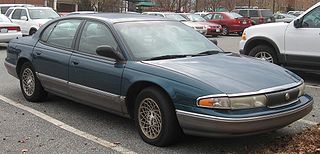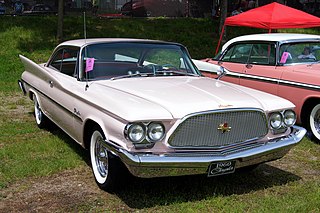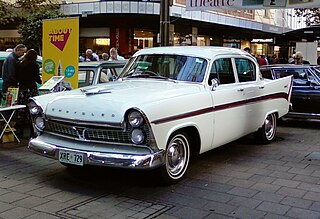
Plymouth was a brand of automobiles produced by Chrysler Corporation and its successor DaimlerChrysler. The brand was launched in 1928 to compete in what was then described as the "low-priced" market segment that was dominated by Chevrolet and Ford. It became a high-volume seller for the automaker until the late 1990s. Plymouth cars were marketed primarily in the United States. The brand was withdrawn from the marketplace in 2001. The Plymouth models that were produced up to then were either discontinued or rebranded as Chrysler or Dodge.

The Chrysler New Yorker is an automobile model that was produced by Chrysler from 1940 until 1996, serving for several decades as either the brand's flagship model or as a junior sedan to the Chrysler Imperial, the latter during the years in which the Imperial name was used within the Chrysler lineup rather than as a standalone brand.

The Chrysler Royal was a full-size car produced by the Chrysler Corporation in the United States. It was first released in 1933 and continued being built until 1934. Then, the model ended production and did not return until 1937 - continuing until 1950.

The Chrysler LeBaron, also known as the Imperial LeBaron, is a line of automobiles built by Chrysler from 1931 to 1941 and from 1955 to 1995. The model was introduced in 1931, with a body manufactured by LeBaron, and competed with other luxury cars of the era such as Lincoln and Packard. After purchasing LeBaron with its parent Briggs Manufacturing Company, Chrysler introduced the luxury make Imperial in 1955, and sold automobiles under the name Imperial LeBaron until 1975. Chrysler discontinued the Imperial brand in 1975, and reintroduced the Chrysler LeBaron in 1977 to what was then Chrysler's lowest priced model.

The Chrysler Sebring is a line of mid-size automobiles that was sold from 1995 through 2010 by Chrysler. Three generations of convertibles, two generations of sedans, and two generations of coupes were produced. Although the coupe shared the same name and some styling cues, it was mechanically unrelated to the other Sebring models.

The Dodge Avenger is a front-wheel drive, mid-sized sedan that was marketed by Dodge. The Avenger made its North American debut in 1994 for the 1995 model year as a coupe that was produced until 2000. The model name was reintroduced to the market as a four-door sports sedan starting in 2007 for the 2008 model year. The Dodge Avenger name had earlier been used on South African market Hillman Avengers in 1975 and 1976.

The Chrysler Imperial, introduced in 1926, was Chrysler's top-of-the-line vehicle for much of its history. Models were produced with the Chrysler name until 1954, after which it became a standalone brand; and again from 1990 to 1993. The company positioned the cars as a prestige marque to rival Cadillac, Continental, Lincoln, Duesenberg, Pierce Arrow, Cord, and Packard. According to Antique Automobile, "The adjective 'imperial' according to Webster's Dictionary means sovereign, supreme, superior or of unusual size or excellence. The word imperial thus justly befits Chrysler's highest priced model."

The Dodge Monaco is an automobile that was marketed by the Dodge division of Chrysler Corporation. Introduced as the flagship of the Dodge product line, the Monaco was introduced for 1965 to replace the Custom 880, then later joining as a sub-model of the Dodge Polara. During its production, the Monaco was offered in multiple body configurations, including two-door and four-door hardtop sedans, four-door sedans, two-door convertibles, and station wagons.

The Dodge Coronet is an automobile that was marketed by Dodge in seven generations, and shared nameplates with the same bodyshell with varying levels of equipment installed. Introduced as a full-size car in 1949, it was the division's highest trim line and moved to the lowest level starting in 1955 through 1959. The name was reintroduced on intermediate-sized models from the 1965 until 1976 model years. Muscle car versions were available starting in 1965 with the 383 and 426 wedge cu in Chrysler RB engine, followed in 1966 by the powerful 426 cu in Chrysler Hemi. Other performance models included the "Superbee", and featured, the 383 cu in Magnum, among other engine options. The nameplate "coronet" is a type of crown worn by royalty.

The Chrysler Saratoga is an automobile built by Chrysler. The nameplate was used from 1939 to 1952 and from 1957 to 1960 in the U.S. market, in Canada through 1965, and in Europe from 1989 to 1995. In the beginning, it was introduced as a sport luxury model, using the Straight Eight engine from the Chrysler New Yorker which was more formal, and the Imperial which had graduated to special order limousine.

The Chrysler Windsor is a full-size car which was built by Chrysler from 1939 through to the 1960s. The final Chrysler Windsor sold in the United States was produced in 1961, but production in Canada continued until 1966. The Canadian 1961 to 1966 Windsor model was for all intents and purposes the equivalent of the Chrysler Newport in the United States.

The Dodge Kingsway is an automobile built by Dodge for export markets. The Kingsway name was adopted for the 1940 models. Before that, the export models based on Plymouth models had no unique model names.

The Dodge Polara is an automobile introduced in the United States for the 1960 model year as Dodge's top-of-the-line full-size car. After the introduction of the Dodge Custom 880 in 1962, the Polara nameplate designated a step below the full-sized best-trimmed Dodge model; the Polara that year had been downsized to what was in effect intermediate, or mid-size status. In its various forms, the Polara name was used by Dodge until 1973, when its position in Dodge's line-up was replaced by the Dodge Monaco.

The Plymouth Gran Fury is a full-sized automobile that was manufactured by Plymouth from 1975 to 1989. The nameplate would be used on successive downsizings, first in 1980, and again in 1982, through what would originally have been intermediate and compact classes in the early 1970s, all with conventional rear-wheel drive layouts. By the time Chrysler ended M-body production in December 1988, they were Chrysler's last remaining rear-wheel drive cars, with a V8 and carburetor, a configuration used since the mid-1950s. Plymouth did not have another rear-wheel drive car until the 1997 Prowler roadster.

The Newport was a name used by Chrysler for both a hardtop body designation and also for its lowest priced model between 1961 and 1981. Chrysler first used the Newport name on a 1940 show car, of which five vehicles were produced. From 1950 to 1956, the Newport name was then used to designate any Chrysler model with a hardtop body style. In 1961, Chrysler introduced the Newport as a new, low-priced model, offering large, comfortable two- and four-door Chrysler models that were modestly priced compared with the Chrysler 300, the Chrysler New Yorker and the Imperial. For 1961, the Newport was priced below the Chrysler Windsor in the Windsor's final year.

The Dodge Meadowbrook is a full-size car that was produced by Dodge in the United States from 1949 to 1954.

The Plymouth Cranbrook is an automobile which was built by Plymouth for the model years 1951 through 1953. It replaced the Special Deluxe when Plymouth changed its naming scheme and was essentially the same as the Plymouth Concord and Cambridge. In period TV commercials, the cars were all introduced as "the new Plymouth" then followed by the model year, and made no mention of the nameplate, which was used to describe the trim package, standard and optional features that were included. The Cranbrook model name was however featured in contemporary sales brochures.

The Chrysler Royal is an automobile which was produced by Chrysler Australia from 1957 to 1963. After investing in tooling to stamp body panels for the 1954 P25 series Plymouth locally, and with Chrysler headquarters in Detroit unwilling to assist in the costs of retooling for the new US models, Chrysler Australia made the decision to develop their own range, using as much of the existing tooling as possible, whilst also realising that the new car had to appear as different as possible. The doors and basic structure of the P25 sedan was retained, and with input from Australian and American Chrysler designers, the 1955 US Plymouth front sheetmetal was adapted to the P25 body and the rear quarter panels redesigned. They also added a wraparound rear windscreen, which caused development problems with Pilkington Glass, the Australian suppliers, who struggled to get the correct curved shape.

The Dodge Series D5 appeared in October 1936 for the 1937 model year, replacing the previous year's Series D2.

The Dodge Series D8 appeared in October 1937 for the 1938 model year, replacing the previous year's Series D5. Production of the 1938 Dodges ran from September 1937 until July 1938, which was the typical pattern for Dodge in this period. As before, there was also a "Junior" line of Plymouths using Dodge badges and trim for the Canadian and global export markets. The main version is sometimes referred to as the "Senior" Dodge to distinguish the two.
























